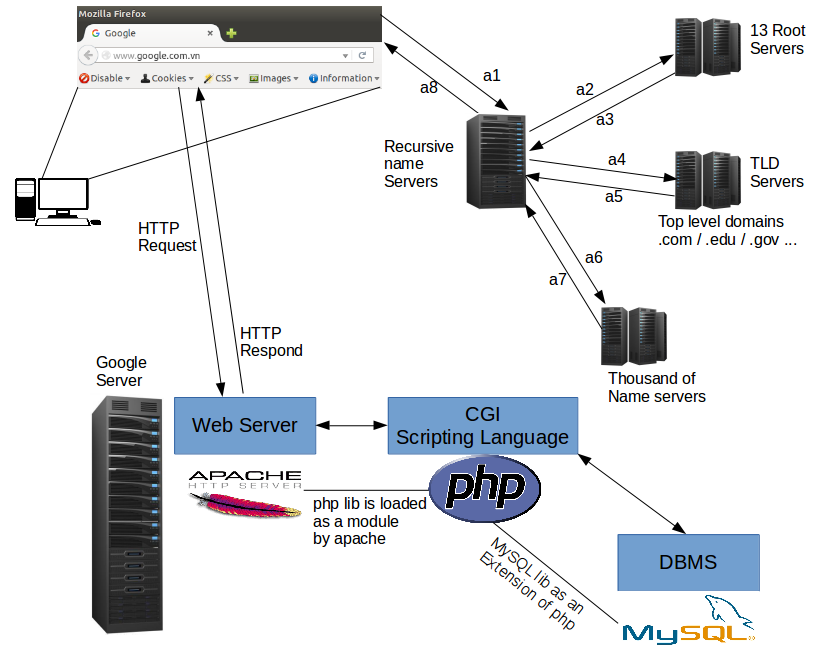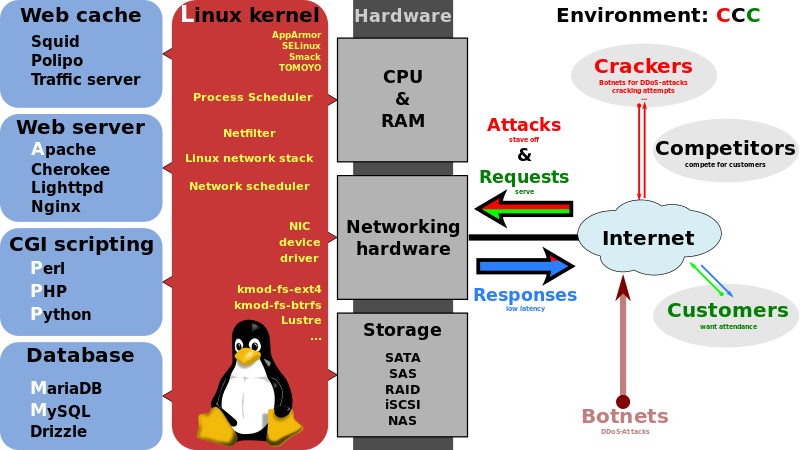Learn web programming - getting started
Hello web programming!
What happened when we enter an URL (a link) into a web browser??

Step1. The browser contact DNS(Domain Name System) to get IP address of server which serve the site
The chain of events to get the IP address for www.google.com:
Ref: How DNS lookups work
(a1) First your browser queries the name server (DNS server) it is setup to use. This is the recursive name server shown above.
How browser know DNS server IP to query on??
=> It is provided by DHCP or your manual setup in network setting
Ref: How browser know DNS server IP
The name server doesn’t know the IP address for www.google.com, so it will start the following chain of queries before it can report back the IP address to your browser.
- (a2,a3) Query the Internet root servers to get the name servers for the .com TLD (top level domain).
- (a4,a5) Query the .com TLD name servers to get the authoritative name servers for google.com.
- (a5,a7) Query the authoritative name servers for google.com to finally get the IP address for the host www.google.com
- (a8) Return that IP address to your browser.
Step2. When got IP address of site’s server (google server), the browser send HTTP request to server to get web pages
What is a web server?
- It just a software that run on a machine and serve HTTP request from client
How a web server work in general?
- It create a socket at specific port (usually on port 80), listen on that port and accept connection from client
- With each connection accepted, web server create a thread to handle user request
- The created thread can return a static web page to user or call a CGI - scripting language to process user data or access database
What is apache?
Ref: What is an apache?
- It is one of the most popular web server (of course there is serveral web server software out there)
Why need CGI - scripting language in general?
- To manipulate on user data and/or access database for specific data then return a web page to web server
- If there isn’t such CGI functions, a web server can only serve static web pages
What is PHP?
- It is one of scripting language along with others like Perl, Python…
Why need DBMS?
A database is a structured collection of data. Here are some typical examples of databases:
- An online store database that stores products, customer details and orders
- A database for a web forum that stores members, forums, topics and posts
- A database for a blog system, such as WordPress, that stores users, blog posts, categories, tags, and comments
The software that manages databases is known as a database management system, or DBMS. MySQL is an example of a DBMS. Rather confusingly, DBMSs are often called databases too. Strictly speaking though, the database is the data itself, while the DBMS is the software that works with the database.
How do Apache, PHP, and MySQL All Work Together?
Ref: How do apache, PHP and MySQL work together?
How PHP interface with apache
Software stack model
Ref: LAMP software bundle
So we normally need a web server, a cgi-scripting language, a DBMS work together on a machine. To do so, we can install each separately or install bundle of those software on specific environment. Example of that software bundle is LAMP which original stand for Linux-Apache-MySQL-PHP (if you’re on window environment you should instead install WAMP package)

There are also other software bundle like this. Example is LYME (a solution stack based on Erlang)
Ref: LYME software bundle
